英语专业本科论文范文
- 格式:wps
- 大小:33.00 KB
- 文档页数:5

××大学毕业设计(论文)题目Analysis of the contextual meaning of English Word 作者张芳丹层次本科专业英语学号指导教师×年×月×日××大学成人高等教育毕业论文(设计)评审表注:此表一式二份,与学籍表一起进入学员毕业档案××大学毕业设计(论文)任务书学院学生姓名:学号:专业:英语1 设计(论文)题目及专题:Analysis of the contextual meaning of English Word2 学生设计(论文)时间:自年月日开始至年月日止3 设计(论文)所用资源和参考资料:〔1〕Nida , E 。
A . Language in Culture and Society。
New York : Harper&Row 。
1964.(the whole book)〔2〕Ogden, C. K and Richard, I。
A。
The Meaning of Meaning 〔M〕. London: Routledge and Kegan PAUL。
1923。
(the whole book) 〔3〕Saeed, J. I。
Semantics. Oxford: Blackwell。
1997。
(from page 53 to 132)〔4〕胡壮麟.语言学教程〔M〕。
北京:北京大学出版社。
2005。
6 (the whole book)〔5〕何伟。
英语语篇中的时态研究。
北京大学出版社.2008.2 (from page 50 to 193)4 设计(论文)完成的主要内容:Ⅰ.Contextual Meaning and Figures of SpeechⅡ。
Contextual Meaning and Culture5 提交设计(论文)形式(设计说明与图纸或论文等)及要求:〔1〕要求认真、独立完成毕业论文(设计)的写作〔2〕要求按照学校规定的论文(设计)格式撰写论文(设计)〔3〕要求及时同指导老师进行沟通,按步骤完成论文(设计)的写作和答辩工作。
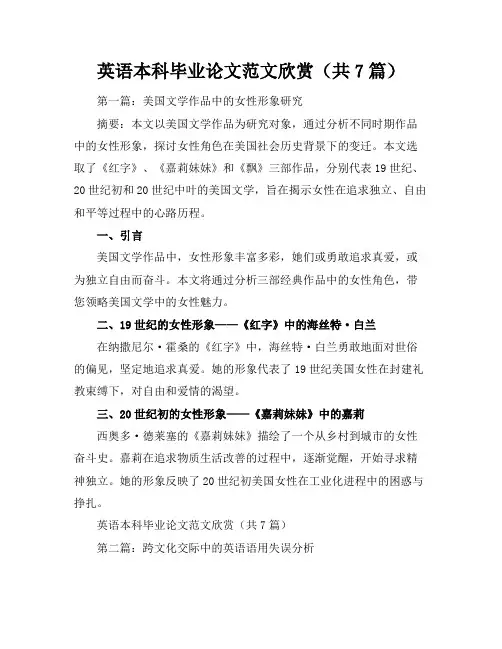
英语本科毕业论文范文欣赏(共7篇)第一篇:美国文学作品中的女性形象研究摘要:本文以美国文学作品为研究对象,通过分析不同时期作品中的女性形象,探讨女性角色在美国社会历史背景下的变迁。
本文选取了《红字》、《嘉莉妹妹》和《飘》三部作品,分别代表19世纪、20世纪初和20世纪中叶的美国文学,旨在揭示女性在追求独立、自由和平等过程中的心路历程。
一、引言美国文学作品中,女性形象丰富多彩,她们或勇敢追求真爱,或为独立自由而奋斗。
本文将通过分析三部经典作品中的女性角色,带您领略美国文学中的女性魅力。
二、19世纪的女性形象——《红字》中的海丝特·白兰在纳撒尼尔·霍桑的《红字》中,海丝特·白兰勇敢地面对世俗的偏见,坚定地追求真爱。
她的形象代表了19世纪美国女性在封建礼教束缚下,对自由和爱情的渴望。
三、20世纪初的女性形象——《嘉莉妹妹》中的嘉莉西奥多·德莱塞的《嘉莉妹妹》描绘了一个从乡村到城市的女性奋斗史。
嘉莉在追求物质生活改善的过程中,逐渐觉醒,开始寻求精神独立。
她的形象反映了20世纪初美国女性在工业化进程中的困惑与挣扎。
英语本科毕业论文范文欣赏(共7篇)第二篇:跨文化交际中的英语语用失误分析摘要:随着全球化进程的加快,跨文化交际日益频繁。
本文聚焦于英语语用失误,分析其在跨文化交际中的表现形式及其产生的原因。
通过对具体案例的深入探讨,本文旨在为英语学习者提供有效的跨文化交际策略。
四、语用失误的定义与分类语用失误是指在交际过程中,由于语言使用不当导致交际目的未能实现的现象。
本文将语用失误分为两类:语用语言失误和社交语用失误,并分别进行阐述。
五、跨文化交际中的语用语言失误案例分析本章节通过具体案例分析,展示了英语学习者在词汇、语法和语篇层面可能出现的语用语言失误,并探讨了这些失误背后的文化差异。
六、跨文化交际中的社交语用失误案例分析社交语用失误往往涉及交际双方的社交规范和文化习俗。

英语专业专业4级作文English:In my opinion, studying English as a major requires a good command of the language, a solid understanding of literature and cultural context, critical thinking skills, and the ability to communicate effectively. As an English major, one must be proficient in reading, writing, speaking, and listening skills in English. This includes having a strong grasp of grammar and vocabulary, as well as the ability to analyze and interpret various texts. Additionally, a deep understanding of literature and cultural context is essential for being able to appreciate and analyze literary works from different periods and regions. Critical thinking skills are also crucial for researching and analyzing various topics, forming well-reasoned arguments, and presenting clear and coherent ideas. Moreover, the ability to communicate effectively, both verbally and in writing, is important for successfully conveying one's thoughts and ideas to others. Overall, studying English as a major not only helps one improve their language skills but also fosters a deeper appreciation for literature, culture, and the intricacies of communication.中文翻译:在我看来,学习英语专业需要对语言有很好的掌握,对文学和文化背景有扎实的理解,具备批判性思维能力以及有效沟通的能力。
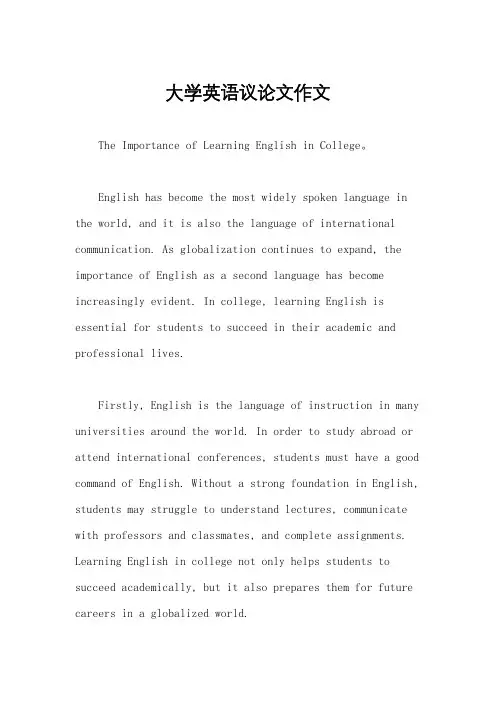
大学英语议论文作文The Importance of Learning English in College。
English has become the most widely spoken language in the world, and it is also the language of international communication. As globalization continues to expand, the importance of English as a second language has become increasingly evident. In college, learning English is essential for students to succeed in their academic and professional lives.Firstly, English is the language of instruction in many universities around the world. In order to study abroad or attend international conferences, students must have a good command of English. Without a strong foundation in English, students may struggle to understand lectures, communicate with professors and classmates, and complete assignments. Learning English in college not only helps students to succeed academically, but it also prepares them for future careers in a globalized world.Secondly, English is the language of business and commerce. In today’s global economy, companies are looking for employees who can communicate effectively with clients and partners from different countries. English proficiency is often a requirement for many jobs, regardless of the industry. By learning English in college, students can increase their chances of finding employment and advancing their careers.Moreover, English is the language of the internet and social media. With the rise of social media platforms like Facebook, Twitter, and Instagram, English has become the dominant language of online communication. By learning English, students can access a wealth of information and connect with people from all over the world. This can broaden their horizons and help them to become more culturally aware and globally minded.In conclusion, learning English in college is essential for students to succeed academically and professionally. It is the language of instruction in many universities, thelanguage of business and commerce, and the language of the internet and social media. By mastering English, students can open up new opportunities and expand their horizons. Therefore, it is important for colleges and universities to provide high-quality English language instruction to their students.。
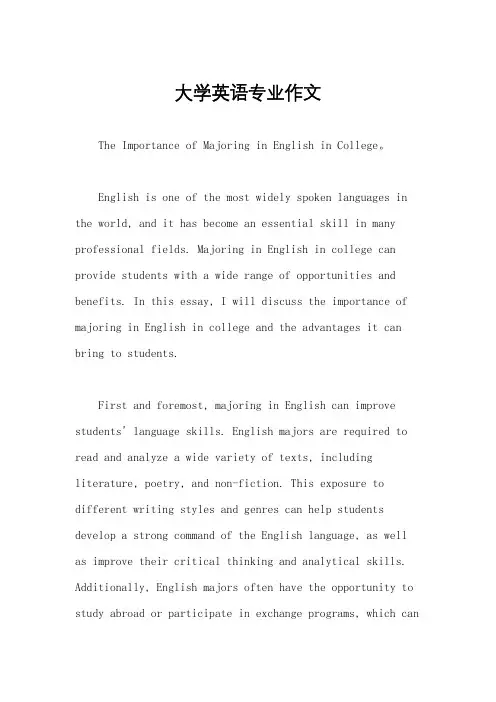
大学英语专业作文The Importance of Majoring in English in College。
English is one of the most widely spoken languages in the world, and it has become an essential skill in many professional fields. Majoring in English in college can provide students with a wide range of opportunities and benefits. In this essay, I will discuss the importance of majoring in English in college and the advantages it can bring to students.First and foremost, majoring in English can improve students' language skills. English majors are required to read and analyze a wide variety of texts, including literature, poetry, and non-fiction. This exposure to different writing styles and genres can help students develop a strong command of the English language, as well as improve their critical thinking and analytical skills. Additionally, English majors often have the opportunity to study abroad or participate in exchange programs, which canfurther enhance their language proficiency and cultural awareness.Furthermore, majoring in English can open up a wide range of career opportunities. In today's globalized world, many companies and organizations are looking for employees who are proficient in English and can effectively communicate with people from different cultural backgrounds. English majors are well-equipped to pursue careers infields such as journalism, publishing, public relations,and international business. They can also work as teachers, translators, or interpreters, or pursue graduate studies in fields such as law, education, or communication.In addition to improving language skills and career prospects, majoring in English can also broaden students' horizons and deepen their understanding of the world. Through the study of literature, students can gain insights into different cultures, historical periods, and social issues. They can also develop empathy and compassion by engaging with diverse characters and perspectives. Moreover, the critical thinking and research skills that Englishmajors acquire can be applied to a wide range of academic and professional pursuits, making them versatile and well-rounded individuals.Despite the numerous benefits of majoring in English, some people may question the practicality of pursuing a degree in this field. They may argue that English majors face limited job prospects and lower earning potential compared to those in STEM or business-related fields. However, it is important to recognize that the skills and knowledge gained from studying English are highly transferable and can be applied to a variety of careers. Moreover, the demand for English language proficiency isonly expected to grow, especially in the fields of technology, marketing, and international relations.In conclusion, majoring in English in college can provide students with valuable skills, career opportunities, and a deeper understanding of the world. By improving language proficiency, critical thinking, and cultural awareness, English majors can become well-roundedindividuals who are prepared to succeed in a diverse andinterconnected global society. Therefore, I believe that majoring in English is a worthwhile and rewarding pursuit for college students.。
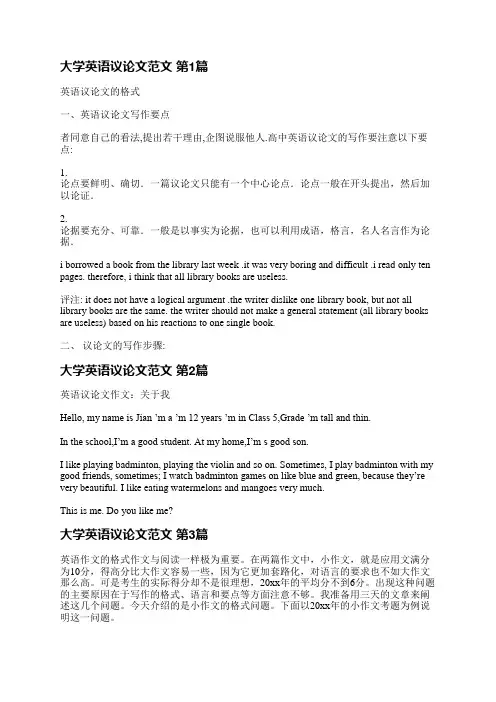
大学英语议论文范文第1篇英语议论文的格式一、英语议论文写作要点者同意自己的看法,提出若干理由,企图说服他人.高中英语议论文的写作要注意以下要点:1.论点要鲜明、确切.一篇议论文只能有一个中心论点.论点一般在开头提出,然后加以论证.2.论据要充分、可靠.一般是以事实为论据,也可以利用成语,格言,名人名言作为论据.i borrowed a book from the library last week .it was very boring and difficult .i read only ten pages. therefore, i think that all library books are useless.评注: it does not have a logical argument .the writer dislike one library book, but not all library books are the same. the writer should not make a general statement (all library books are useless) based on his reactions to one single book.二、议论文的写作步骤:大学英语议论文范文第2篇英语议论文作文:关于我Hello, my name is Jian ’m a ’m 12 years ’m in Class 5,Grade ’m tall and thin.In the school,I’m a good student. At my home,I’m s good son.I like playing badminton, playing the violin and so on. Sometimes, I play badminton with my good friends, sometimes; I watch badminton games on like blue and green, because they’re very beautiful. I like eating watermelons and mangoes very much.This is me. Do you like me?大学英语议论文范文第3篇英语作文的格式作文与阅读一样极为重要。
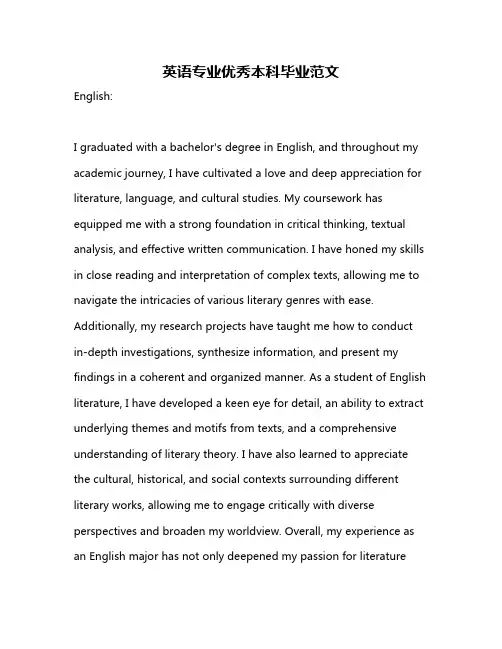
英语专业优秀本科毕业范文English:I graduated with a bachelor's degree in English, and throughout my academic journey, I have cultivated a love and deep appreciation for literature, language, and cultural studies. My coursework has equipped me with a strong foundation in critical thinking, textual analysis, and effective written communication. I have honed my skills in close reading and interpretation of complex texts, allowing me to navigate the intricacies of various literary genres with ease. Additionally, my research projects have taught me how to conduct in-depth investigations, synthesize information, and present my findings in a coherent and organized manner. As a student of English literature, I have developed a keen eye for detail, an ability to extract underlying themes and motifs from texts, and a comprehensive understanding of literary theory. I have also learned to appreciate the cultural, historical, and social contexts surrounding different literary works, allowing me to engage critically with diverse perspectives and broaden my worldview. Overall, my experience as an English major has not only deepened my passion for literatureand language but has also equipped me with valuable skills that can be applied in a variety of professional settings.中文翻译:我获得了英语学士学位,通过整个学术之旅,我培养了对文学、语言和文化研究的热爱和深刻欣赏。
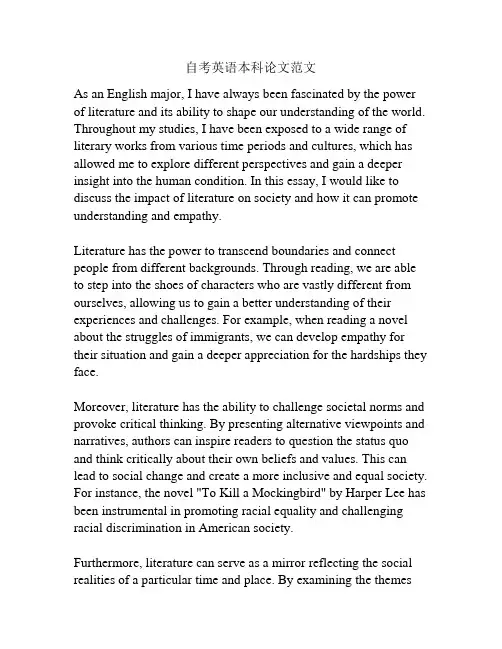
自考英语本科论文范文As an English major, I have always been fascinated by the power of literature and its ability to shape our understanding of the world. Throughout my studies, I have been exposed to a wide range of literary works from various time periods and cultures, which has allowed me to explore different perspectives and gain a deeper insight into the human condition. In this essay, I would like to discuss the impact of literature on society and how it can promote understanding and empathy.Literature has the power to transcend boundaries and connect people from different backgrounds. Through reading, we are able to step into the shoes of characters who are vastly different from ourselves, allowing us to gain a better understanding of their experiences and challenges. For example, when reading a novel about the struggles of immigrants, we can develop empathy for their situation and gain a deeper appreciation for the hardships they face.Moreover, literature has the ability to challenge societal norms and provoke critical thinking. By presenting alternative viewpoints and narratives, authors can inspire readers to question the status quo and think critically about their own beliefs and values. This can lead to social change and create a more inclusive and equal society. For instance, the novel "To Kill a Mockingbird" by Harper Lee has been instrumental in promoting racial equality and challenging racial discrimination in American society.Furthermore, literature can serve as a mirror reflecting the social realities of a particular time and place. By examining the themesand issues presented in a work of literature, we can gain insights into the social, political, and cultural contexts in which it was written. This allows us to better understand the historical and cultural factors that shape our world today. For example, George Orwell's dystopian novel "1984" offers a critique of totalitarianism and serves as a warning against the dangers of an oppressive government.In addition, literature can also provide solace and comfort during difficult times. When faced with personal struggles or challenges, reading can offer an escape and provide a sense of comfort and understanding. It can remind us that we are not alone in our experiences and that others have gone through similar hardships. This can offer hope and encouragement, inspiring us to overcome our own obstacles.In conclusion, literature plays a vital role in society by promoting understanding, empathy, and critical thinking. It has the power to transcend boundaries and connect people from different backgrounds, challenge societal norms, reflect social realities, and provide solace and comfort. By engaging with literature, we can broaden our horizons, gain a deeper understanding of the world, and become more empathetic and compassionate individuals.。
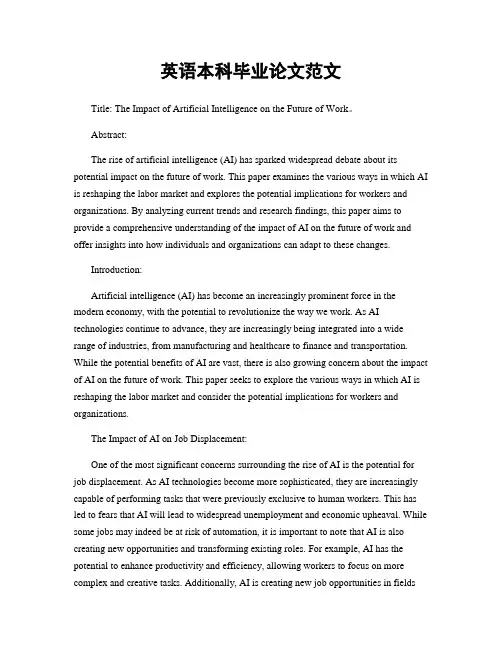
英语本科毕业论文范文Title: The Impact of Artificial Intelligence on the Future of Work。
Abstract:The rise of artificial intelligence (AI) has sparked widespread debate about its potential impact on the future of work. This paper examines the various ways in which AI is reshaping the labor market and explores the potential implications for workers and organizations. By analyzing current trends and research findings, this paper aims to provide a comprehensive understanding of the impact of AI on the future of work and offer insights into how individuals and organizations can adapt to these changes.Introduction:Artificial intelligence (AI) has become an increasingly prominent force in the modern economy, with the potential to revolutionize the way we work. As AI technologies continue to advance, they are increasingly being integrated into a wide range of industries, from manufacturing and healthcare to finance and transportation. While the potential benefits of AI are vast, there is also growing concern about the impact of AI on the future of work. This paper seeks to explore the various ways in which AI is reshaping the labor market and consider the potential implications for workers and organizations.The Impact of AI on Job Displacement:One of the most significant concerns surrounding the rise of AI is the potential for job displacement. As AI technologies become more sophisticated, they are increasingly capable of performing tasks that were previously exclusive to human workers. This has led to fears that AI will lead to widespread unemployment and economic upheaval. While some jobs may indeed be at risk of automation, it is important to note that AI is also creating new opportunities and transforming existing roles. For example, AI has the potential to enhance productivity and efficiency, allowing workers to focus on more complex and creative tasks. Additionally, AI is creating new job opportunities in fieldssuch as data analysis, machine learning, and software development. Therefore, while job displacement is a valid concern, it is important to recognize that AI is also creating new opportunities for workers.The Impact of AI on Job Quality:In addition to job displacement, there is also concern about the impact of AI on the quality of jobs. As AI technologies continue to advance, they have the potential to change the nature of work and the skills required to succeed in the labor market. For example, AI is increasingly being used to perform routine and repetitive tasks, which has the potential to lead to a greater emphasis on non-routine and cognitive skills. This could lead to a shift in the types of jobs available and the skills required to succeed in the labor market. Additionally, there is concern that AI could lead to greater job insecurity and a decline in job quality, as workers may be required to adapt to new technologies and work in more precarious and unstable employment arrangements. Therefore, while AI has the potential to create new opportunities, it is also important to consider the potential implications for the quality of jobs and the skills required to succeed in the labor market.The Impact of AI on Organizational Dynamics:In addition to its impact on individual workers, AI is also reshaping the dynamics of organizations. As AI technologies continue to advance, they are increasingly being integrated into a wide range of organizational processes, from decision-making and customer service to supply chain management and marketing. This has the potential to transform the way organizations operate and the skills and capabilities required to succeed. For example, AI has the potential to enhance decision-making and strategic planning, allowing organizations to make more informed and data-driven decisions. Additionally, AI is creating new opportunities for organizations to automate routine tasks and streamline their operations, which has the potential to enhance productivity and efficiency. However, the integration of AI into organizational processes also raises concerns about the potential for job displacement and the need for workers to adapt to new technologies and work in more dynamic and uncertain environments. Therefore, it isimportant for organizations to consider the potential implications of AI on their operations and the skills and capabilities required to succeed in the future.Conclusion:The rise of artificial intelligence has the potential to reshape the labor market and the way we work. While there are valid concerns about the potential impact of AI on job displacement and job quality, it is important to recognize that AI is also creating new opportunities for workers and organizations. By understanding the potential implications of AI on the future of work, individuals and organizations can better prepare for these changes and adapt to the evolving labor market. Therefore, it is important for policymakers, educators, and business leaders to consider the potential implications of AI on the future of work and develop strategies to ensure that workers are equipped with the skills and capabilities required to succeed in the AI-driven economy.。
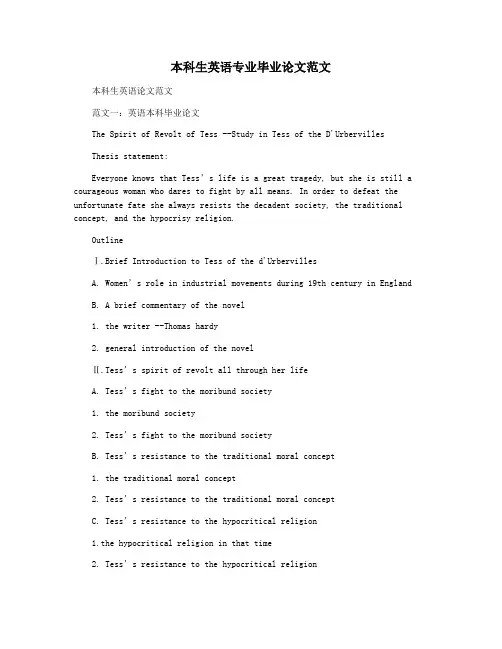
本科生英语专业毕业论文范文本科生英语论文范文范文一:英语本科毕业论文The Spirit of Revolt of Tess --Study in Tess of the D'UrbervillesThesis statement:Everyone knows that Tess’s life is a great tragedy, but she is still a courageous woman who dares to fight by all means. In order to defeat the unfortunate fate she always resists the decadent society, the traditional concept, and the hypocrisy religion.OutlineⅠ.Brief Introduction to Tess of the d'UrbervillesA. Women’s role in industrial movements during 19th century in EnglandB. A brief commentary of the novel1. the writer --Thomas hardy2. general introduction of the novelⅡ.Tess’s spirit of revolt all through her lifeA. Tess’s fight to the moribund society1. the moribund society2. Tess’s fight to the moribund societyB. Tess’s resistance to the traditional moral concept1. the traditional moral concept2. Tess’s resistance to the traditional moral conceptC. Tess’s resistance to the hypocritical religion1.the hypocritical religion in that time2. Tess’s resistance to the hypocritical religionD. Tess’s resistance to the unfort unate marriage1.Tess’s unfortunate marriage2. Tess’s resistance to the unfortunate marriageⅢ.Conclusion: In a word, Tess has shown a powerful woman's image to common people with her unyielding spirit of revolt. She, to the moribund society, traditional old morals, hypocritical religion, capitalist marriage system, has carried on the strongest revealing and criticism. Her kindhearted enlightenment, noble emotion, strong personality, and her resistance inimbuing all rooted in the hearts of the people forever, worth savoring.AbstractThis paper mainly focuses on the spirit of revolt of Tess. First of all, this paper begins with a brief introduction to the novel. Then, this paper makes a brief commentary of the novel. Moreover, it concen trates on :1 Tess’s fight to the moribund society. 2 Tess’s resistance to the traditional moral concept. 3 Tess’s resistance to the hypocritical religion. 4 Tess’sresistance to the unfortunate marriage. And at last the paper reveals thatTess is actually a character with the spirit of revolt all through her life.key of revolt,industrial movement,unfortunate fate内容提要本文研究的是小说主人公“苔丝”的“反抗精神”。
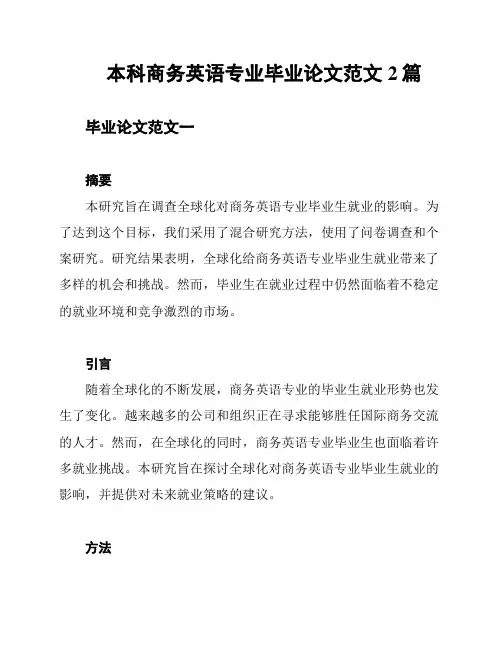
本科商务英语专业毕业论文范文2篇毕业论文范文一摘要本研究旨在调查全球化对商务英语专业毕业生就业的影响。
为了达到这个目标,我们采用了混合研究方法,使用了问卷调查和个案研究。
研究结果表明,全球化给商务英语专业毕业生就业带来了多样的机会和挑战。
然而,毕业生在就业过程中仍然面临着不稳定的就业环境和竞争激烈的市场。
引言随着全球化的不断发展,商务英语专业的毕业生就业形势也发生了变化。
越来越多的公司和组织正在寻求能够胜任国际商务交流的人才。
然而,在全球化的同时,商务英语专业毕业生也面临着许多就业挑战。
本研究旨在探讨全球化对商务英语专业毕业生就业的影响,并提供对未来就业策略的建议。
方法本研究采用了混合研究方法,包括问卷调查和个案研究。
问卷调查用于收集大量的毕业生就业数据,个案研究则用于深入了解个别毕业生的就业经历。
我们对一所大学商务英语专业的毕业生进行了调查,共有200名毕业生参与了问卷调查,同时选择了10名毕业生进行个案研究。
结果根据问卷调查和个案研究的结果,我们发现全球化给商务英语专业毕业生就业带来了机会和挑战。
大多数毕业生认为全球化提供了更多的就业机会,特别是在跨国公司和国际组织中。
然而,毕业生在就业过程中也面临着不稳定的就业环境和竞争激烈的市场。
此外,毕业生需要具备优秀的跨文化沟通能力和实践经验才能在全球化时代脱颖而出。
结论在全球化时代,商务英语专业的毕业生面临着机遇和挑战。
为了增加就业竞争力,毕业生需要不断提升自己的专业能力和跨文化沟通能力。
同时,政府和高校也应该加强对商务英语专业毕业生的培养和引导,为他们提供更多的就业机会和资源。
毕业论文范文二摘要本研究旨在探讨企业社交媒体在商务英语专业中的应用。
通过对一家跨国公司的个案研究,我们发现企业社交媒体对商务英语专业学生的英语写作和跨文化交流能力有着积极的影响。
然而,企业社交媒体的应用也面临着一些挑战,需要综合考虑各种因素。
引言企业社交媒体在商务领域的应用越来越普遍。
成人本科学位英语作文范文3篇英文回答:1. What are the benefits of obtaining an adultbachelor's degree?Increased earning potential: Studies have consistently shown that individuals with a bachelor's degree earn significantly more than those with only a high school diploma.Improved job opportunities: A bachelor's degree opens doors to a wider range of career options and promotions.Enhanced critical thinking and problem-solving skills: University coursework develops critical thinking, analytical, and problem-solving abilities, which are essential for success in today's workplace.Personal growth and fulfillment: Pursuing a bachelor'sdegree as an adult is a rewarding experience that can leadto personal growth, self-discovery, and a sense of accomplishment.2. What are the challenges of pursuing an adultbachelor's degree?Time constraints: Adult learners often face competing demands from work, family, and other responsibilities,which can make it difficult to balance schoolwork.Financial considerations: The cost of tuition andother expenses can be a significant burden for adult students who may have financial obligations such as mortgages or child care.Balancing work and school: Managing the demands ofboth work and school can be challenging, particularly for students who have full-time jobs or family responsibilities.Adapting to a university environment: Adult learners may need to adjust to the pace and structure of universitycoursework, which can be different from their previous educational experiences.3. How to overcome the challenges of pursuing an adult bachelor's degree?Set realistic goals: Start by setting small, achievable goals that you can gradually build upon.Manage your time effectively: Prioritize your tasks and use time management techniques to make the most of your study time.Seek support: Don't hesitate to reach out to family, friends, or university resources for support and encouragement.Explore financial aid options: Research scholarships, grants, and loans that can help offset the cost of tuition.Consider online or part-time programs: Online andpart-time programs offer flexibility and can make it easierfor adult learners to balance work and school.中文回答:1. 获得成人学士学位的益处:增加收入潜力,研究始终表明,拥有学士学位的人的收入远高于只有高中学历的人。
英语本科论文范文Abstract:This paper explores the profound effects of social media onthe way individuals communicate with one another. With the rapid advancement of technology and the ubiquity of social media platforms, the dynamics of interpersonal communication have been significantly altered. This study aims toinvestigate how social media has transformed the nature of communication, the benefits and drawbacks of this transformation, and the implications for future communication practices.Introduction:The advent of social media has revolutionized the way we interact with each other. Platforms such as Facebook, Twitter, Instagram, and LinkedIn have become integral parts of ourdaily lives, influencing how we maintain relationships and share information. This paper delves into the impact ofsocial media on interpersonal communication, examining boththe positive and negative aspects.Literature Review:Previous studies have highlighted various aspects of social media's impact on communication. Some research has focused on the benefits, such as increased connectivity and the abilityto maintain relationships across long distances. Otherstudies have examined the potential downsides, including the superficiality of online interactions and the potential forsocial isolation.Methodology:This research utilizes a mixed-methods approach, combining quantitative surveys with qualitative interviews to gatherdata on the experiences and perceptions of social media users.A sample of 300 participants was selected through stratified random sampling to ensure a diverse representation of age, gender, and social media usage patterns.Results:The findings indicate that while social media has enhancedthe ease of communication and broadened the scope of oursocial networks, it has also led to a decrease in the quality of interpersonal interactions. Survey responses revealed that a majority of participants felt that social mediainteractions lacked the depth and emotional connection offace-to-face communication.Discussion:The results are discussed in the context of existing literature, with a particular focus on the paradox of increased connectivity leading to feelings of isolation. The role of social media in shaping communication norms and the potential for fostering superficial relationships is also explored.Conclusion:Social media has undeniably transformed interpersonal communication, offering new ways to connect and share information. However, this paper suggests that there is aneed for a balanced approach to social media usage, one that acknowledges its benefits while being mindful of itspotential to erode the quality of our interactions. Future research should continue to monitor the evolving landscape of social media and its impact on human communication.References:A comprehensive list of academic sources, including journal articles, books, and online resources, is provided to support the arguments and findings presented in this paper.。
附件2A FOLLOW-UP STUDY ON TRANSFERRED TEACHERS’ ENGLISHPRONUNCIATION—A Case in GuangdongA DISSERTATION SUBMITTED IN PARTIAL FULFILLMENT OF THE REQUIREMENTS FOR THE DEGREE OF BACHELOR OF ARTSByJACKIE LAMSupervised byProf. Noble HofmannSOUTH CHINA NORMAL UNIVERSITY,GUANGZHOU,P。
R. CHINAJUNE, 2006ACKNOWLEDGEMENTSThe completion of this study could never have been possible without the assistance of many people related。
First and foremost,I would like to show my heartfelt gratitude to my supervisor,Professor XXX。
Knowledgeable and responsible,Prof. X provided me with valuable guidance and support in every stage of writing this thesis。
He made well—informed and enlightening comments on the organization of the chapters, took pains to go through in great detail every draft of the thesis.Thanks are due to Associate Professor XX,Miss YY and Miss PP, who helped me a lot in collecting data.I would like to express my great gratitude to my classmate FFF, and my dear Australian teacher KK, who have been of great help in analyzing the data. They have been very patient and responsible throughout the whole work。
英语专业⽂学论⽂范⽂3篇英语专业英美⽂学论⽂⼀、注重培养⽂学鉴赏能⼒、审美能⼒以及⽂学研究能⼒,即“三个培养”。
1)⽂学鉴赏能⼒。
⽂学鉴赏是基于领会⽂学作品所包含的思想内容的⼀种审美活动。
⽂本理解是鉴赏的前提,鉴赏是理解的必然要求。
学习英美⽂学,不能只停留在理解阶段,必须把培养学⽣的⽂学鉴赏能⼒作为重要教学⽬标。
在英美⽂学课堂,培养学⽣的⽂学鉴赏能⼒主要注意三点:⼀是要敦促学⽣⼴泛阅读,⼴闻博见,在此基础上摄取录制。
⼆是要勤于思考,充分想象。
⽂学作品的鉴赏,必须经历想象创造的过程。
最后⼀点是学⽣要对作品产⽣真实感悟。
读者只有和作者⼼息相通,才能唤起内⼼对真善美的向往,将读书升华为灵魂之间的交流,这才是读书的最⾼境界。
2)审美能⼒。
⽂学作品具有认识作⽤、教育作⽤和审美作⽤三⼤功能。
在英美⽂学课堂培养学⽣的审美能⼒要坚持“⼀个中⼼,两个基本点”。
“⼀个中⼼”即以阅读原汁原味的英语⽂本为中⼼。
⽆论⽂本难易与否,都要要求学⽣坚持读下去,不能半途⽽废。
“两个基本点”即在“⼀个中⼼”的基础上引导学⽣发现作品形式上基本的艺术美以及内容上的基本的⾃然美、社会美以及⽣活美等。
经典的英美⽂学作品皆为英美名家的杰作,教师应教会学⽣去发现、模仿⽂本中的⾳韵美、修辞美、⽂体美以及⽂本意外的思想美、⽣活美等。
总之,“美”是⽂学艺术的最⾼境界。
审美能⼒的培养是⽂学课程的重要任务之⼀。
在英美⽂学课教学中,我们不仅要使学⽣通过学习,提⾼对于英语语⾔和⽂化的认识能⼒,更要积极培养学⽣的审美能⼒,使得英美⽂学课程担负起全⾯提⾼学⽣素质的重任。
3)研究能⼒。
⽂学创作与⽂学研究可谓相依为命。
⽂学作品⼀旦问世,⽂学研究便随即产⽣。
因此在英美⽂学课堂,教师除了要注重培养学⽣的上述能⼒之外,还应注重培养其从事⼀般⽂学研究的能⼒。
郑秀恋、吴俊等⼈的问卷调查结果表明,学⽣在毕业论⽂写作中,选英美⽂学的⼈数最多,分别占30%、39.75%。
这表明,作为⼀个研究⽅向⼤类,英美⽂学研究因容易获取研究资料和研究切⼊点⽽备受学⽣青睐。
专生本英语议论文作文模板Introduction。
In today's globalized world, English has become the dominant language for communication in various fields such as business, education, and technology. As a result, there is a growing demand for English language proficiency among students worldwide. In this essay, we will discuss the benefits of studying English as a second language at the undergraduate level and how it can enhance students' academic and professional prospects.Body。
1. Academic Benefits。
Studying English at the undergraduate level can provide students with a solid foundation in the language, enabling them to excel in their academic pursuits. Proficiency in English can open doors to a wide range of academicopportunities, including access to a wealth of knowledgeand resources available in English. Moreover, it can enhance students' ability to conduct research, write papers, and participate in discussions, thereby improving their overall academic performance.2. Professional Benefits。
英语论文范文篇一:英文论文范例CONTENTS(以上字体Times New Roman, 小3号;加粗)(以下字体均为:Times New Roman;小4号;行距:1.5倍) ACKNOWLEDGEMENTS Abstract (in English) (1)Abstract (inChinese) (1)Ⅰ Introduction (1)1.1Multi-Media With Erroneous Zones (1)1.1.1 Erroneous Zone 1 (2)1.1.2 Erroneous Zone 2 (2)1.1.3 Erroneous Zone 3 (2)1.1.4 Erroneous Zone 4 (3)ⅡCountermeasures (3)2.1 UnsuitableOperation (4)2.2 Over stimulation In Courseware (4)2.3 Vague Content with AutomaticalTransformatio n (5)2.4 Neglect Of Teachers’Function (5)ⅢConclusion…………………………………………………………………………. .63.1 Prospect in English Teaching (6)3.2 Personal Opinions of Further Research (6)BIBLIOGRAPHY (7)DECLARATIONDiscussion on the Application of Multi-mediaIn English Teaching(字体:Times NewAbstract: With the rapid development of computer and popularization of the network, the present teaching pattern that still uses traditional teaching method “one chalk, one blackboard” seems to be unable to meet the requirements in the present society any longer, and English teaching is no exception. The introduction of the multi-media teaching method to the English class has been one of the tendencies to the development of English teaching. But the misuse of the modern tools will surely result in the bad effect to English teaching. So English teachers should take an active part in the research of how to use the multi-media teaching method in English teaching and try to avoid its misuses.Key words: multi-media; English teaching; overcome(英文摘要和关键词都是两边对齐;5号字;行距:单倍;字体:Times New Roman;“Abstract” 和“Key words” 两个词或词组要加粗)(关键词之间用分号隔开;词与词之间相隔一个英文字符)(空一行)摘要:随着电脑和网络的迅速发展,那种“一盒粉笔,一块黑板”的传统教学模式的应用已远远不能满足现代社会对教学的需要。
英语专业本科论文范文A Brief Analysis of english teaching in senior high schoolAbstract: Classroom teaching is the main way for students to learn En glish. But in senior high school, a lots of probelms still exsit in t he English teaching especially in the teaching of reading and writing. In this paper, the importance and methods of reading and writing w ill be further discussed. Key words: reading writing techniqu esIntroduction: Classes should be learner-centered, with meaningful, fu nctional activities, often, classes begin by finding out what the stu dents don’t know. These classes operate on the assumption that there is a great deal of information that students lack and that the teache r and textbooks will impact that information to the students. Teacher s who hold this assumption view students as plants waiting passively to be fed and watered. But I think the students should be regarded as explorers, active learners who bring a great deal to the learning pr ocess and at the same time, draw from their environment as they devel op new understandings. The basic principle will be used in the teachi ng of reading and writing.Section One------ How to teach readingI. Why teach readingThere are many reasons why getting students to read English texts is an important p art of the teacher’s job. In the first place, many of them want to be able to read texts in English either for their career s, for study purposes or simply for pleasure. Anything we can do to m ake reading easier for them must be a good idea.Reading texts provide good models for English writing, provide opp ortunities to study language vocabulary, grammar, punctuation, and th e way to construct sentences, paragraphs and texts. Lastly, good read ing texts can introduce interesting topics, stimulate discussion, exc ite imaginative responses and be the springboard for well-rounded, fa scinating lessons.The last but not the least, students must read widely because only a fraction of knowledge about the world can come from other experien ces in their short lives.II. What kind of reading should students do?When the teachers give reading class to students, they should noti ce a balance----a balance to be struck between real English on the on e hand and the students’ capabilities and interests on the other. Th ere is some authentic written material which beginner students can understand to some degree: menus, timetables, signs and basic instructi ons, for example, and, where appropriate, teachers can use these. But for longer prose, teachers can offer their students texts, which, wh ile being like English, are nevertheless written or adapted especiall y for their level. Anyway, the materials to be read should be interes ting and meaningful. Teachers should become better acquainted with bo oks written specially for teenagers and dealing with their problems. III. What are the principles behind the teaching of reading?i) Permit Students To ReadNo one has learned to swim by practicing the skills of backstrokes, f lutter kicks or treading water while staying on the edge of the swimm ing pool. Yet, in the teaching of reading teachers often do just that. Rather than let the students into “the water”, teachers keep them in skills books learning rules about letters, syllables or definition s of words rather than letting them into the book itself, permitting them to be immersed in the language which comes from the authors as the readers try to reconstruct the written message.ii) Encourage students to respond to the content of a reading text, n ot just to the languageOf course, it is important to study reading texts for the way they us e language, how many paragraphs they contain and how many times they use relative clauses. But the meaning, the message of the text, is mu ch more important. Teachers should help students understand that the main reason to read is for them. They have to have their own purpose to read and reading must make sense, they have to find ways of doing something about it. They should be encouraged either to reread or to continue reading to gain meaning. But they must realize that the mean ing is not in the teacher, but in the interaction between the reader and author. Students should be encouraged to ask themselves repeatedl y, “Does this make sense to me?” Students should be encouraged to r eject and to be intolerant of reading materials that do not make sens e.iii) Encourage students to guess or predictReaders’ guesses or predictions are based on the cumulative infor mation and syntactic structure they have been learning as they have b een reading. Therefore, their guesses are more often than not appropr iate to the materials. Students have to realize that risk taking in r eading is appropriate; that using context to decide what words mean i s a proficient reading strategy and that they have the language sense to make appropriate guesses which can fit both the grammatical and s emantic sense of what they are reading.iv) Match the task to the topicOnce a decision has been taken about what kind of reading text the students are going to read, teachers need to choose good reading tas ks—the right kind of questions and useful puzzles, etc. Asking borin g and inappropriate questions can undermine the most interesting text; the most commonplace passage can be made really exciting with imagin ative and challenging tasks. Working in groups, the English teacher a nd students take turns asking each other questions following the read ing. The teacher may ask, “ What is the significance of the characte r’s age?” These questions require inferences based on details from the reading text.Section Two------How to teach writing (Developing correctness in stud ents’ writing)“Students learn to write by writing, and they learn to write co rrectly by writing, revising, and proofreading their own work”---wit h some help or direction from the teacher when it is necessary. They do not learn to write correctly by studying about writing or doing is olated workbook exercises unrelated to their own writing. So, the mos t important technique a teacher can use to guide students toward gram matically correct writing is to let them write, let them write things related to their own experiences. There is no limit to the kinds of text the teacher can ask students to write. Teachers’ decisions, tho ugh, should based on how much language the students know, what their interests are.“Do I read a paper and ignore all punctuation, what good is that for studentsWe spend hours at night with papers---I’m not sure the students get as much from it as the time I spend on it.”These comments by senior high school English teachers discussing the process of marking student papers reflect the dissatisfaction an d frustration of many teachers over the problem of dealing with the e rrors in student writing-----the obvious mistakes in spelling, punctu ation----Traditionally, teachers have worked to correct errors in two ways: by teaching grammatically correctness through exercise in gram mar texts; by pointing out all errors when making student papers.Most students find it very dispiriting if they get a piece of wr itten work back and it is covered in red ink, underlings and crossing -out. It is a powerful visual statement of the fact that their writte n English is terrible. Of course, some pieces of written work are com pletely full of mistakes, but even in these cases, the teacher has to achieve a balance between being accurate and truthful on the one hand and treating students sensitively and sympathetically on the other.Some techniques can be used in dealing with the errors in studen t papers:i) SelectivityRather than engage in intensive error-correction when responding to s tudent writing, teachers are encouraged to adopt a more moderate appr oach to error. If the teacher over-corrects the students’ mistakes, the students would be likely to focus on errors instead of ideas. Stu dents are more likely to grow as writers when the teacher’s primary purpose in reading student papers is to respond to content. However, if attention to content and correctness are combined when making pape rs, it is more helpful to select one or two kinds of errors the indiv idual student is making than to point out every error in the paper. T he teacher can identify a selected error, show an example or two on t he student paper, and either explain the correct form or direct the s tudent to a handbook for further explanation. It is always worth writ ing a comment at the end of a piece of written work -----anything fro m “Well done” to “This is a good story, but you must look again at your use of past tenses---see X grammar book page xx.”ii) Error-analysisAnother method for working with student error, one that can be especi ally fruitful for teachers, is to approach it from an analytic perspe ctive. Teachers, as error-analyst, look for patterns in the errors of an individual student, tries to discover how the mistake arrived at the mistakes by analyzing the error (Lack of knowledge about a certai n grammatical point; A careless one or a mis-learned rule?), and plan s strategies accordingly.iii) Publish Student WritingThe final basic strategy is publishing. Students need a reason for la boring over a draft until it is perfect; the urge to see oneself in p rint can be a powerful drive toward revision and proofreading.Conclusion: As teachers to the students who are in senior high sch ool, they shoul d learn to turn students’ hard work toward supporting the language strengths students already have, proving students with a feeling of success, finding materials and planning classroom experie nces will turn students on to reading and writing, the reading and wr iting will develop with much greater ease than it does at the present time.Reference:Gu Xueliang, The Basic Technical Training in English Teaching, Hangzh ou University Press, 1998.Wilga M.Rivers & Mary S. Temperley, A practical guide to the teaching of English as a second or foreign Language, New York: Oxford Univers ity Press, 1978Smith F. Understanding Reading (2d ed), New York: Holt, Rinehart an d Winston, 1978David Freeman&Yvome S. Freeman, 龚雅芳&张连忠&李静军(编辑),英语教学基本讲座,北京师范学院出版社,1991。